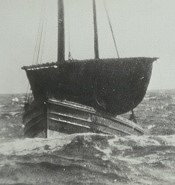Herring Home | Fishing for herring | Back to Early Scottish Fishing Boats
The Lugsail
Most of the early Scottish fishing boats carried lugsails. A lugsail is a nearly square sail set on a ‘lug’ or yard. The yard is a bar of wood that crosses the mast. The yard could be raised and lowered on the mast, so the rig was called a dipping lugsail. With a dipping lugsail, the yard was hauled up the mast about a third of the way from the front, so that when the sail was up, its top tipped higher at the back. The bottom corners of the sail were pulled tight by two ropes (a halyard and a sheet) to catch the wind. The canvas was set low down giving stability to these boats. This simple arrangement made the lugsail very reliable.

Dipping lugsails dominated the Scottish herring fleet, and sometimes the boats were called luggers. It was a powerful sail and so the vessels could go very fast. Speed was important as it meant the herring could be brought quickly back to shore. The other advantage was that these boats tended to have no bowsprit or bars projecting beyond the hull so they could be packed close together in the busy herring fishery harbours.
There was one major problem with the lugsail. When the wind changed direction, the sail had to be lowered or dipped, lifted round the mast, and hoisted again on the new tack. This was known as tacking. Handling the sails required much skill and teamwork from of the crew. On a large boat, the process could take 10 minutes. In rough weather, dipping the lug was dangerous as the boat could lose power during the change and steering was difficult. Heavy seas could cause it to lurch violently and crew members could easily be thrown overboard. Tacking made the boat awkward in small spaces.
Herring Home | Fishing for herring | Back to Early Scottish Fishing Boats